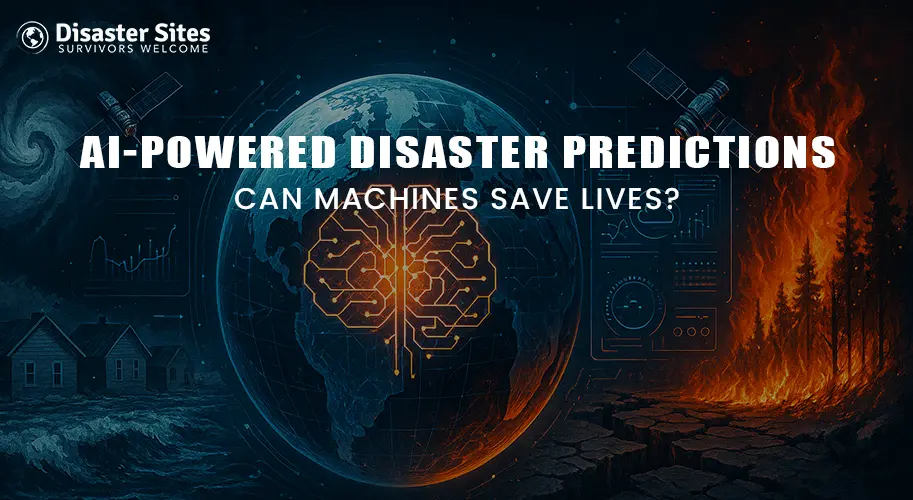We use cookies to personalise site content, social media features and to analyse our traffic. We also share information about your use of this site with our advertising and social media partners.
FEATURED
SPONSORED
VERIFIED

Thu at 12:49 AM -
8 minutes, 7 seconds
-119 Views 0 Comments 0 Likes 0 Reviews

All around the world, natural disasters are increasingly being seen in both frequency and intensity. Millions of people experience the impacts of natural disasters every year from floods, hurricanes, wildfires, till earthquakes and many more, often with little to no warning. Natural disasters do not only take lives but they also create significant devastation on people and their homes, as well as on infrastructure, and entire economies.
This pattern presents a major issue and also raises the question; how we may better approach decelerating the onset of disasters in the first place. Current forecasting methods offer an answer, but at times are not as timely or accurate as we might prefer or expect, leaving many communities unable and unprepared for disaster strikes.
The use of Artificial Intelligence (AI) is changing the game. AI systems use an abundance of data to spot early warning signs, track patterns, and make estimates faster and usually more accurate than humans do. The question remains—when lives are at stake and time is limited, can machines truly save lives?
Artificial Intelligence is like an advanced, super fast detective of digital information, it processes enormous amounts of information in a matter of seconds. In disaster predictions, AI will process data from satellites, weather stations, ocean buoys and even social media updates to better see what’s happening in real time.
Machine learning models - programs that "learn" from previous events - provide scientists the help of early warning signals. For example, AI has learned that when meteorologists depict sharp winds in a storm (as documented in many thousands of storms in the past), those currents indicate an upcoming tidal wave.
AI is not restricted by human calculation unlike past forecasting methods that are long and finite in value, it can see patterns that humans miss. This makes predictions not only high speed but also more accurate, thus providing more time to prepare.
Traditional causes of disasters are still critical to understand, as covered in What Triggers Natural Disasters? A Beginner’s Guide.
Throughout the world, AI must have already become very important in disaster management. Real time data analysis and learning from previous events aid authorities to better prepare, respond, and recover from adverse situations. These applications genuinely display how technology can save lives.
Major Applications of AI in Disasters:
For example, past case studies such as Japan’s Deadly Floods and Landslides in July 2025 show where AI tools could have made a major difference.
Compared with traditional methods, AI-based disaster forecasting offers several other advantages-and by bringing massive amounts of data into crisp, convincing warnings, AI is enabling communities, governments, and organizations to act swiftly.
Key Benefits of AI in Disaster Forecasting:
These benefits complement existing preparedness strategies such as those outlined in Government Strategies for Effective Natural Disaster Management.
Disaster management will likely include AI and other emerging technologies in the near-future. In particular, AI can be combined effectively with the Internet of Things (IoT), drone technology and satellite images enabling authorities to get much better real-time data on the risk zones. Drones can quickly fly over the damaged areas, satellites can provide data on storm intensity, and IoT provides on the ground updates that AI can instantly compile into a summary of actionable insights.
AI has been viewed as one of the best tools to reduce the effects of natural disasters. Given that it can forecast floods, monitor hurricanes, and assess the risk of wildfires, precautionary measures can be put into place so that some communities prepare better and respond more correctly. Although AI will never become an agent to prevent a disaster, one of the good predictions should keep most of the chaos created by the final impact on those lives.
However, AI is no panacea. AI predictions must be informed by sound data, reliable infrastructure, and human decision making for it to make a measurable impact. As technology continues to grow, there is still significant potential for greater cooperation between the predictive capabilities of AI and the effectiveness of human disaster response that intervention can save lives and mitigate harm - both globally and locally - showing that the world is a safer place when machines and humans work together.

“To assist disaster survivors by providing a source for them to come together in time of need, to aid in the listing of events, information and other forms of assistance, and continuing support through the recovery process.”
Share this page with your family and friends.